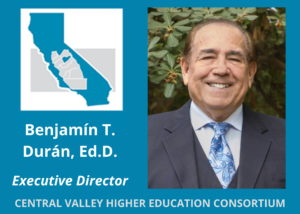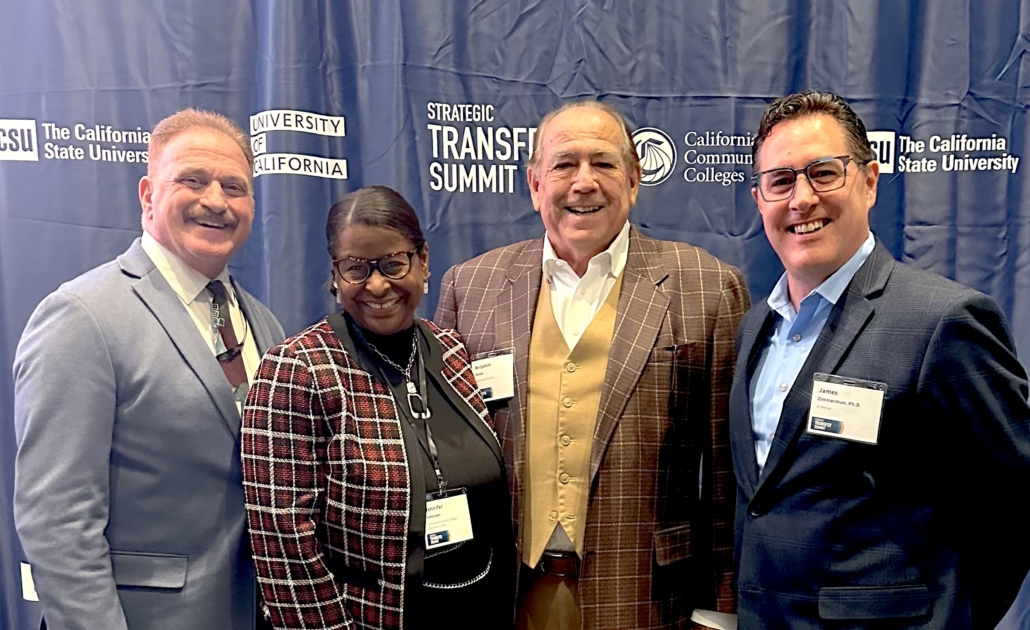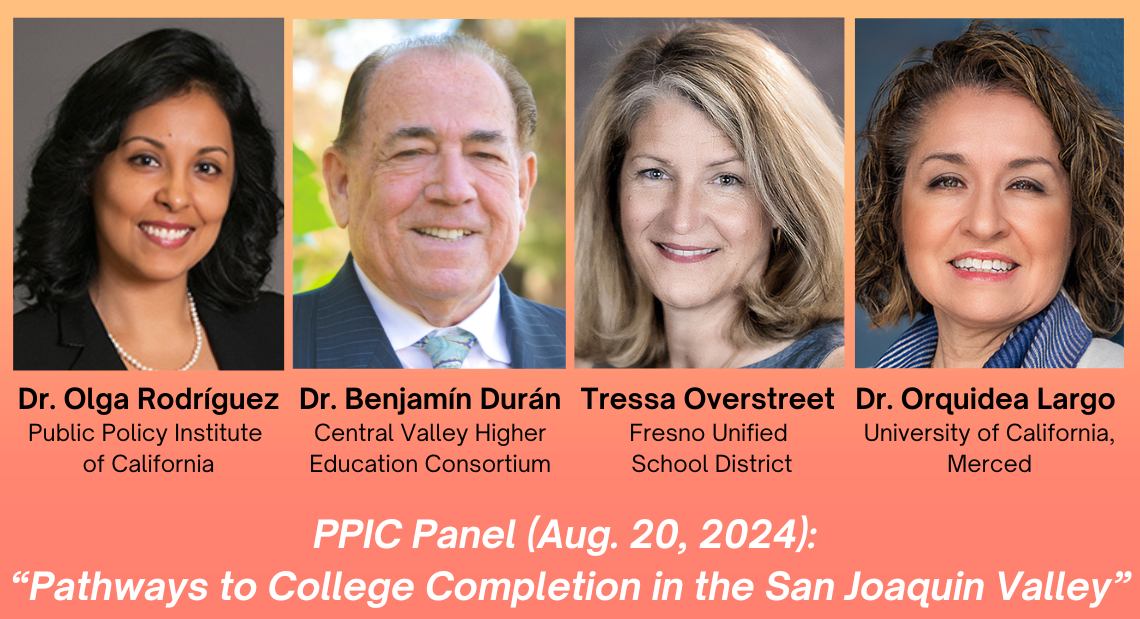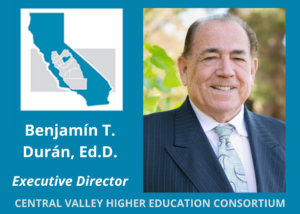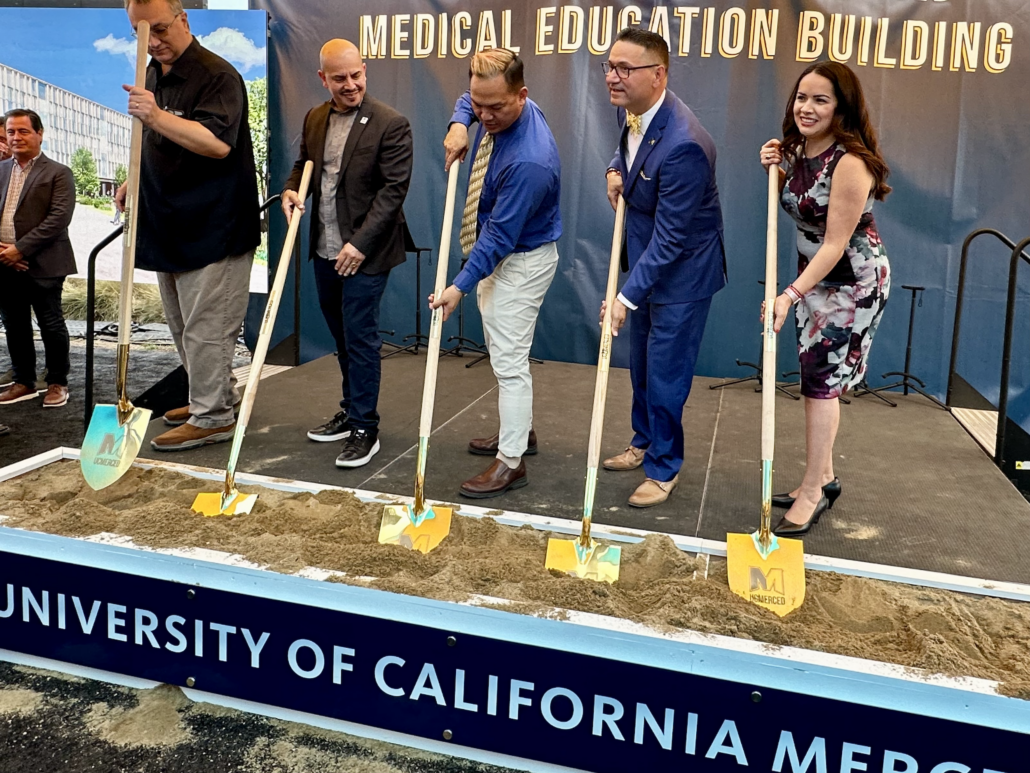CVDEEP Task Force convening for educators in 10-county region to look at strategic planning, policy changes, student success and equity REGISTER HERE The Central Valley Dual Enrollment for […]
Executive Director Benjamín Durán (third from left) led the CVHEC delegation at the Strategic Transfer Summit with Transfer Project Lead Stan Carrizosa, Jennifer Johnson of California Community Colleges Foundation and Dr. James Zimmerman of UC Merced. (Photo below): The California Economic Summit in October was attended by Ángel Ramírez, Elaine Cash, Tom Uribes (back), Priscilla Arrellano posing with Assemblyman Joaquin Arambula.
Strategic Transfer Summit provides showcase for
CVHEC’s Transfer Project as reps make the rounds
Central Valley Higher Education Consortium delegations are making the rounds this fall at several state and national conferences including the recent Strategic Transfer Summit presented by the California Community Colleges Nov. 8 at UC Merced.
Other destinations include the Complete College America National Conference in Indianapolis Nov. 18-20; the American Mathematical Association of Two-Year Colleges (AMATYC) in Atlanta Nov. 14-17 through the Dana Center with CVHEC Math Task Force members Jeremy Brandl of Fresno City College and Shelley Getty of Taft College; and the Community Colleges League of California Nov. 22 in Sacramento.
 CVHEC also attended the California Economic Summit held Oct. 8-10 in Sacramento.
CVHEC also attended the California Economic Summit held Oct. 8-10 in Sacramento.
At the recent Transfer Summit, CVHEC’s Transfer Project team presented an update on its progress in partnering with the consortium’s 15 community college members using the Program Pathway Mapper software for a smoother transfer process for students. Leading the CVHEC delegation at the UC Merced event was Executive Director Benjamín Durán and Transfer Lead Stan Carrizosa along with James Zimmerman vice chancellor of UC Merced and Jennifer Johnson California Community Colleges Foundation.
Carrizosa said the summit, attended by the chief executive officers of the state’s three public higher ed segments – the University of California, the California State University and the California Community Colleges – provided a prime opportunity to showcase the consortium’s Transfer Project.
“The participation of the statewide CEOs of CCC, CSU & UC — coupled with powerful student testimony — makes this event an inflection point that sets our Transfer Project on its next upward trajectory,” Carrizosa said.
 CVHEC’s Transfer Project has been designated as a California Community Colleges Demonstration Project by Chancellor Sonya Christian to serve as a model systemwide.
CVHEC’s Transfer Project has been designated as a California Community Colleges Demonstration Project by Chancellor Sonya Christian to serve as a model systemwide.
This month, Duran will also attend the CLCC in Sacramento as well as lead the CVHC delegation to the CAC national conference in Indiana. Attending the CAC with him will be Angel Ramirez, operations/finance director; Elaine Cash, grants coordinator; and Tom Uribes, communications/media coordinator.
For the CA Economic Summit in October, Ramirez, Cash and Uribes were joined by Priscilla Arrellano, administrative specialist.
A sweeping new report, “Pathways to College Completion in the San Joaquin Valley,” by the Public Policy Institute of California (PPIC) found a multitude of factors contributing to lower […]
California’s San Joaquin Valley (SJV) has the lowest college enrollment and completion rates in the state, which both reflects and perpetuates the region’s economic challenges. Yet it could […]
New PPIC report shows the San Joaquin Valley with lowest
college enrollment and completion rates in the state
Panel to discuss strategies for strengthening college-going pathways in the valley
UPDATE AUG. 15 (Public Policy Institute of California):
Dr. Benjamín Durán, executive director of the Central Valley Higher Education Consortium, will join a virtual panel of experts discussing a new report to be released next week by the Public Policy Institute of California, “Pathways to College Completion in the San Joaquin Valley,” showing California’s San Joaquin Valley has the lowest college enrollment and completion rates in the state.
The panel, set for Tuesday, Aug. 20 from 11 a.m. to noon, is presented by PPIC and will explore how institutions, educators and policymakers can expand support for college-going pathways in the valley.
Joining Dr. Durán on the panel — moderated by Dr. Olga Rodríguez, director of the PPIC Higher Education Center and a senior fellow at PPIC — will be Dr. Orquidea Largo, associate vice chancellor and chief outreach officer for the Center for Educational Partnerships, University of California, Merced; and Tressa Overstreet, executive director of College & Career Readiness for the Fresno Unified School District. (See detailed bios on the PPIC event page).
The report, which PPIC will release Aug. 15, notes that “with its youthful, diverse, growing population; expanding economy; and robust regional networks, the San Joaquin Valley could be on the verge of dramatic improvements in college enrollment and completion.”
Durán said PPIC’s work helps shed light on an issue CVHEC has tackled head-on since its inception 22 years ago this week.
“We applaud PPIC for undertaking this valuable work focusing on ongoing issues and barriers we sometimes encounter that too often still impede student success,” Durán said.
“It is important for valley educators to continuously confront these barriers and address the value of creating meaningful pathways such as dual enrollment courses supported by wrap-around services like our Math Bridge Program and to implement initiatives like our Transfer Project that complement those pathways, all leading to more student success.”
A question/answer session the final 15 minutes will close the PPIC panel. To submit questions: ppiceventquestions@gmail.com
Registration is now available for the free Zoom event.
The PPIC research and its panel event are supported with funding from College Futures Foundation, the Bill & Melinda Gates Foundation and the Sutton Family Fund.
For report and panel event questions:
PPIC EVENT CONTACT: Sal Beeby, events associate (415.291.4426)
PPIC MEDIA CONTACT: Steven Bliss, director of Digital Strategy (415.291.4412)
CVHEC Media Contact (for Dr. Durán): Tom Uribes, cvhecommunications@mail.fresnostate.edu (559.348.3278)

